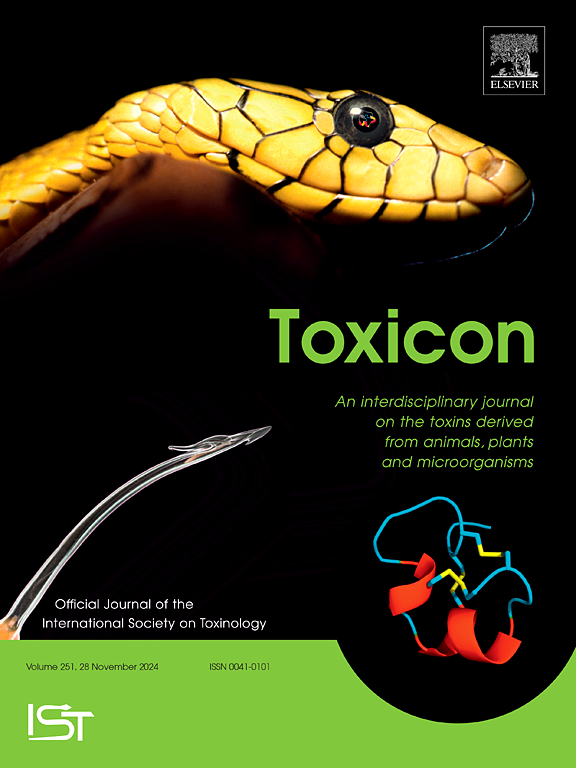八种天然马兜铃内酰胺的体外肾毒性和结构毒性关系。
IF 2.6
4区 医学
Q2 PHARMACOLOGY & PHARMACY
引用次数: 0
摘要
马兜铃内酰胺(ALs)和马兜铃酸(AAs)在结构上的相似性不断引发人们对含 ALs 植物安全性的担忧。天然马兜铃内酰胺的分布范围比马兜铃酸更广,因此在日常消费中接触马兜铃内酰胺的风险更高。本研究旨在评估和比较菲环和酰胺环上具有不同取代基的八种天然烷醇对人类肾小管上皮细胞(HK-2 细胞)的体外肾毒性、包括马兜铃内酰胺Ⅰ(AL Ⅰ)、AL BⅡ、velutinam、AL AⅡ、sauristolactam、AL AⅠa、AL FⅠ和 N-甲基哌啶内酰胺 A。采用甲基噻唑基四氮唑(MTT)试验检测了它们对细胞活力的 IC50 值,并采用酶联免疫吸附试验(ELISA)测定了肾损伤分子-1(KIM-1)、转化生长因子-β1(TGF-β1)和纤连蛋白(FN)的水平。活性氧(ROS)测定用于检测细胞内氧化应激水平。结果表明,8种AL均对HK-2细胞具有特异性肾毒性。其中,ALⅠ、AL BⅡ和velutinam对HK-2细胞的细胞毒性(IC50 = 2.49-2.78 μM)比其他五种AL(IC50 = 12.33-43.84 μM)更强。结构-毒性关系表明,亚甲二氧基(-OCH2O-)和甲氧基(-OCH3)是 ALs 对肾毒性有积极影响的官能团,而羟基(-OH)和氮上的甲基取代(N-CH3)则相反,对肾毒性有不利影响。与这种结构-毒性关系相一致的是,在相同浓度(2.5 μg/mL)下,八种AL使KIM-1水平升高的趋势与其细胞毒性相同,这与ROS生成水平不同有关。而毒性最强的四种ALs,即ALⅠ、AL BⅡ、velutinam和AL AⅡ,也能通过增加TGF-β1和FN水平诱导纤维化。本文章由计算机程序翻译,如有差异,请以英文原文为准。

In vitro nephrotoxicity and structure-toxicity relationships of eight natural aristolactams
The structural similarity between aristolactams (ALs) and aristolochic acids (AAs) raises constant concerns about the safety of ALs-containing plants. Natural ALs are distributed more extensively than AAs, leading to a higher risk of ALs exposure in daily consumption. This study aimed to evaluate and compare the in vitro nephrotoxicity on human renal tubular epithelial cells (HK-2 cells) of eight natural ALs with different substituents on the phenanthrene ring and amide ring, including aristolactam Ⅰ (AL Ⅰ), AL BⅡ, velutinam, AL AⅡ, sauristolactam, AL AⅠa, AL FⅠ and N-methyl piperolactam A. Their IC50 values of cell viability were tested by 3-(4,5-dimethylthiazol-2-yl)-2,5-diphenyltetrazolium bromide (MTT) assay, and enzyme-linked immunosorbent assay (ELISA) was used to determine the levels of kidney injury molecule-1 (KIM-1), transforming growth factor-β1 (TGF-β1) and fibronectin (FN). The reactive oxygen species (ROS) assay was used to detect the intracellular oxidative stress level. The results showed that the eight ALs all had specific nephrotoxicity on HK-2 cells. Particularly, AL Ⅰ, AL BⅡ and velutinam exhibited more potent cytotoxicity on HK-2 cells (IC50 = 2.49–2.78 μM) than the other five ALs (IC50 = 12.33–43.84 μM). The structure-toxicity relationships indicated that both methylenedioxy (-OCH2O-) and methoxy (-OCH3) were positively contributing functional groups of ALs on nephrotoxicity, while the hydroxy group (-OH) and methyl substitution on nitrogen (N-CH3) accounted for a detrimental effect conversely. Consistent with this structure-toxicity relationship, the eight ALs increased KIM-1 levels in the same trend as their cytotoxicity at the same concentration of 2.5 μg/mL, associating with different levels of ROS generation. And the four most toxic ALs, AL Ⅰ, AL BⅡ, velutinam and AL AⅡ, could also induce fibrosis by increasing TGF-β1 and FN levels.
求助全文
通过发布文献求助,成功后即可免费获取论文全文。
去求助
来源期刊

Toxicon
医学-毒理学
CiteScore
4.80
自引率
10.70%
发文量
358
审稿时长
68 days
期刊介绍:
Toxicon has an open access mirror Toxicon: X, sharing the same aims and scope, editorial team, submission system and rigorous peer review. An introductory offer Toxicon: X - full waiver of the Open Access fee.
Toxicon''s "aims and scope" are to publish:
-articles containing the results of original research on problems related to toxins derived from animals, plants and microorganisms
-papers on novel findings related to the chemical, pharmacological, toxicological, and immunological properties of natural toxins
-molecular biological studies of toxins and other genes from poisonous and venomous organisms that advance understanding of the role or function of toxins
-clinical observations on poisoning and envenoming where a new therapeutic principle has been proposed or a decidedly superior clinical result has been obtained.
-material on the use of toxins as tools in studying biological processes and material on subjects related to venom and antivenom problems.
-articles on the translational application of toxins, for example as drugs and insecticides
-epidemiological studies on envenoming or poisoning, so long as they highlight a previously unrecognised medical problem or provide insight into the prevention or medical treatment of envenoming or poisoning. Retrospective surveys of hospital records, especially those lacking species identification, will not be considered for publication. Properly designed prospective community-based surveys are strongly encouraged.
-articles describing well-known activities of venoms, such as antibacterial, anticancer, and analgesic activities of arachnid venoms, without any attempt to define the mechanism of action or purify the active component, will not be considered for publication in Toxicon.
-review articles on problems related to toxinology.
To encourage the exchange of ideas, sections of the journal may be devoted to Short Communications, Letters to the Editor and activities of the affiliated societies.
 求助内容:
求助内容: 应助结果提醒方式:
应助结果提醒方式:


